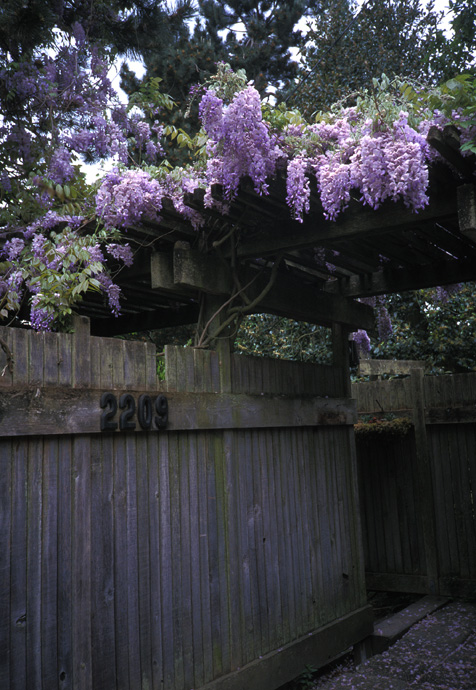
|
Vines
|
| Humans gripe about rain; vines rejoice in it. Seattle has lots of
happy vines, some 100 feet long or more. They love tremendous rains (we're
8 inches above normal this year) and summer warmth, responding
luxuriously. They elongate as if ecstatic. |
| Most of Seattle's wild growing vines were brought here from
elsewhere and are now naturalized. There are only three native species which
have been growing here for thousands of years. Foremost in interest is
poison oak (Toxicodendron diversiloba). As a rule, oaks are trees, but
poison oak, like poison ivy, is not related to oaks in general, and is a vine of
the cashew or sumach family. In Seattle it is rare, apparently confined
to Seward Park, Lincoln Park, and west Beacon Hill. It favors hot, dry,
well exposed sites. Although blooming now, its flowers are
inconspicuous. However, its electric red fall color is breathtakingly beautiful. No part
of it be should allowed to touch you or your pets. |
| Pink honeysuckle (Lonicera
hispidula), and orange honeysuckle (Lonicera
ciliosa) are two native vines with colorful flowers and berries.
Hummingbirds pollinate them. You can suck the nectar out of the flowers if
you beat the birds. Both of these are common in Seattle, but the
orange-flowered species is mainly a woodlander, the pink favors open,
brushy bluffs. Here and there the European woodbine or honeysuckle
(Lonicera Periclymenum) grows wild in Seattle. It smells heavenly, and is
not especially weedy, so I consider its presence a blessing, not a curse. In
New England, Hall's Japanese honeysuckle (Lonicera
japonica) is a serious weed. In Seattle it is a delightful garden plant bearing sweet flowers all summer;
it rarely if ever comes up wild. |
| Of the wild, non-native vines which can be so aggressive as to
gobble acreage, eat houses or swallow trees, the main villains are ivy
(Hedera Helix 'Hibernica') and wild clematis
(Clematis Vitalba), both from Europe. Ivy makes a lovely smothering carpet of evergreen
leaves. Clematis fills ravines and greenbelts, clambering up trees,
providing strong stems which children use to play Tarzan. Clematis makes
pretty flowers of creamy-white, followed in winter by attractive puffy
seed-clusters. Both of these vines are being purged from parks by native
plant proponents, in a vegetative version of ethnic cleansing. Moderate
growth of non-natives adds beneficial richness to our wild diversity; excessive
or cancerous growth clearly decreases diversity. People must referee.
So prune your wayward vines. |
Various other vines grow wild occasionally, but are of lesser impact,
or rare occurrence. The main ones are wisteria
(Wisteria spp.), grapes (Vitis spp.), bittersweet
(Celastrus orbiculatus), silver lace vine or
fleeceflower (Polygonum Aubertii), and Virginia creeper
(Parthenocissus quinquefolius). Less woody or strictly herbaceous vines include
wild morning glories or bindweeds (Calystegia
sepium and Convolvulus arvensis), bittersweet nightshade
(Solanum dulcamara), and hops (Humulus
Lupulus).
|
(originally published in The Seattle Weekly, June 1997)
Back |
|
|

